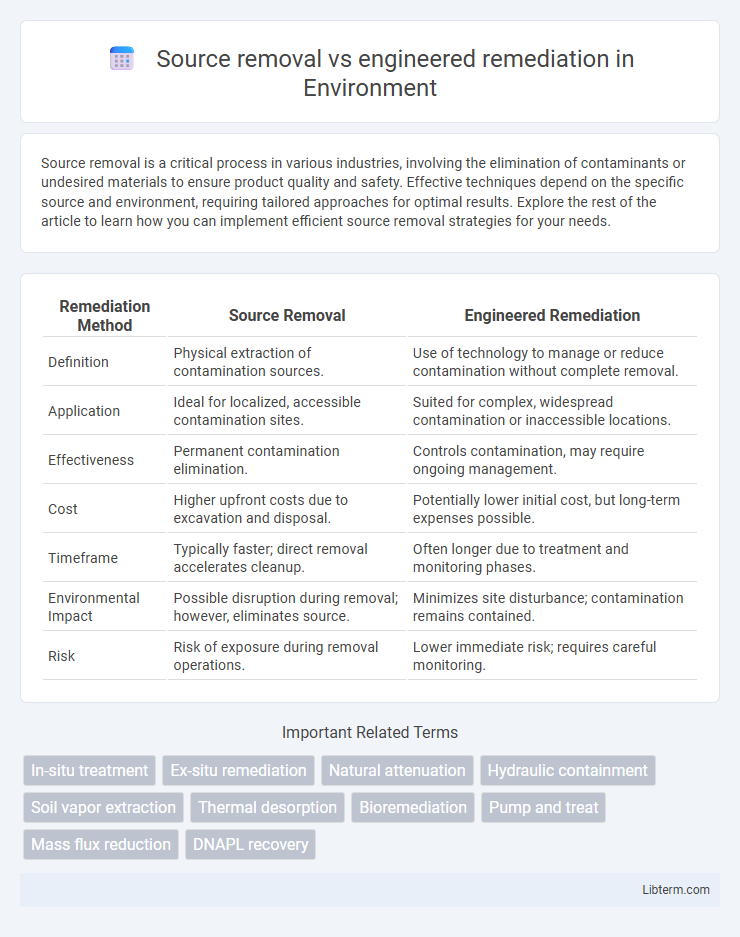Source removal is a critical process in various industries, involving the elimination of contaminants or undesired materials to ensure product quality and safety. Effective techniques depend on the specific source and environment, requiring tailored approaches for optimal results. Explore the rest of the article to learn how you can implement efficient source removal strategies for your needs.
Table of Comparison
| Remediation Method | Source Removal | Engineered Remediation |
|---|---|---|
| Definition | Physical extraction of contamination sources. | Use of technology to manage or reduce contamination without complete removal. |
| Application | Ideal for localized, accessible contamination sites. | Suited for complex, widespread contamination or inaccessible locations. |
| Effectiveness | Permanent contamination elimination. | Controls contamination, may require ongoing management. |
| Cost | Higher upfront costs due to excavation and disposal. | Potentially lower initial cost, but long-term expenses possible. |
| Timeframe | Typically faster; direct removal accelerates cleanup. | Often longer due to treatment and monitoring phases. |
| Environmental Impact | Possible disruption during removal; however, eliminates source. | Minimizes site disturbance; contamination remains contained. |
| Risk | Risk of exposure during removal operations. | Lower immediate risk; requires careful monitoring. |
Introduction to Contaminant Management Strategies
Source removal eliminates contaminants at their origin, effectively reducing pollutant loads and preventing further environmental spread. Engineered remediation employs physical, chemical, or biological techniques to treat contaminated media in situ or ex situ, targeting residual contaminants and restoring site conditions. Both strategies play critical roles in comprehensive contaminant management, optimizing site-specific risk reduction and long-term environmental health.
Defining Source Removal in Environmental Remediation
Source removal in environmental remediation involves the direct extraction or elimination of pollutants from contaminated sites, aiming to eradicate the primary pollutant mass to prevent further environmental dispersion. This method targets contaminants embedded in soil, groundwater, or sediment through techniques like excavation, soil vapor extraction, or pump-and-treat systems, offering a definitive solution to contamination. Engineered remediation, by contrast, often focuses on containing or stabilizing pollutants in situ to control migration rather than complete removal.
Overview of Engineered Remediation Techniques
Engineered remediation techniques encompass methods such as soil vapor extraction, bioremediation, thermal desorption, and chemical oxidation designed to treat contaminated media in situ or ex situ. These strategies actively degrade, remove, or immobilize pollutants, addressing subsurface contamination beyond mere source removal. Effectiveness depends on site-specific conditions, contaminant types, and regulatory requirements, offering targeted contaminant reduction in complex environmental settings.
Key Differences Between Source Removal and Engineered Remediation
Source removal directly eliminates contaminants from the environment, providing a permanent solution by physically extracting pollutants from soil or groundwater. Engineered remediation employs engineered systems such as pump-and-treat, air sparging, or bioremediation to reduce contaminant concentrations but may require ongoing operation and maintenance. The key difference lies in source removal's focus on contaminant extraction versus engineered remediation's emphasis on contamination control and gradual treatment.
Effectiveness of Source Removal Approaches
Source removal techniques involve the direct extraction or elimination of contaminants from soil or groundwater, which often leads to immediate reductions in pollutant concentrations and prevents further spread of contamination. Engineered remediation, such as in-situ chemical oxidation or bioremediation, relies on transformative processes that degrade or stabilize pollutants but may require longer time frames to achieve significant cleanup levels. Effectiveness of source removal approaches is typically higher in achieving rapid risk reduction and site closure, especially for discrete contaminant hotspots, whereas engineered methods favor complex matrices or widespread contamination where physical extraction is challenging.
Applications and Limitations of Engineered Remediation
Engineered remediation techniques, such as soil vapor extraction and bioremediation, are widely applied to degrade or contain contaminants, offering effective solutions for complex or deep-seated pollution sources. These methods excel in situations where direct source removal is impractical due to site conditions, regulatory constraints, or cost considerations but can be limited by the time required for contaminant breakdown and potential incomplete removal of hazardous compounds. While engineered remediation supports long-term contaminant control and risk reduction, it may not fully eliminate sources, necessitating careful site assessment and ongoing monitoring to ensure effectiveness.
Cost Considerations: Source Removal vs Engineered Remediation
Source removal generally incurs higher upfront costs due to excavation, transportation, and disposal of contaminated materials, but it offers a definitive solution by eliminating the contamination source. Engineered remediation often involves lower initial expenses but may require long-term operation and maintenance, leading to increased cumulative costs over time. Evaluating cost-effectiveness depends on site-specific factors such as contamination extent, regulatory requirements, and long-term risk management.
Environmental and Human Health Impacts
Source removal directly eliminates contamination by extracting pollutants from soil or groundwater, significantly reducing long-term environmental and human health risks. Engineered remediation stabilizes or contains contaminants, preventing their spread but may require ongoing monitoring due to residual hazards. Source removal often results in faster restoration of ecosystems and reduced exposure pathways, while engineered approaches mitigate immediate toxic risks without complete contaminant elimination.
Regulatory Guidelines and Compliance Factors
Regulatory guidelines for source removal emphasize rapid elimination of contamination to meet clear soil and groundwater cleanup standards set by agencies like the EPA and state environmental departments. Engineered remediation must comply with long-term monitoring and performance criteria defined under frameworks such as CERCLA and RCRA, ensuring containment systems and treatment technologies meet permit requirements. Compliance factors include documentation of remedial actions, risk assessments, and adherence to site-specific cleanup goals that align with regulatory thresholds for human health and environmental protection.
Choosing the Right Remediation Approach: Factors to Consider
Choosing between source removal and engineered remediation depends on site-specific factors such as contaminant type, concentration, and extent of contamination. Source removal is often preferred for localized, high-concentration pollutants, enabling permanent elimination, while engineered remediation suits diffuse or complex contamination requiring containment or treatment. Cost, timeframe, regulatory requirements, and environmental impact should also guide the selection of the optimal remediation approach.
Source removal Infographic

 libterm.com
libterm.com